|
Part Three
The purpose of this additional page is to try to take what has been
said before, on many pages of this site, and to try to distill it
into something just a little more definitive... even though it’s
fairly obvious that for as many dents as can be made into the
mysteries of the Templars and of Rennes-le-Chateau, there is so much
yet to consider, and so little overall success that has been made,
even if the grandest ambitions and capabilities of our more modern
ancient wisemen have already been identified here. Most of the
images on this page are toward the bottom, so please bear with me.
While some of the purpose and principles of C. S. Lewis’ "Aslan" and
other characters may have been identified, the exact nature still
awaits precise identification, and a detailed analysis of the work
in general may never have been done. The full analysis of the
paintings of Poussin, Teniers, and others, involving not only their
symbolism and geography, but probably most importantly, the
importance of their hidden mathematics, still remain probably not
only yet uncompleted, but still unattempted if even fully
contemplated, and in general the meaning of the ambitious, gigantic
pentagons and pentagrams formed by the Templars remains still
unspecified.
Suffice it to say that those responsible for the mystery may have
had a much broader pallete than they get credit for; it’s quite
possible that there are myriad reasons for relying on Teniers and
Poussin as part of the clues, and these names could yet also prove
to be cypher keys (re-read the famous phrase carefully), they may
never have deviated from the goal that is apparent in Poussin’s "Et
in Arcadia Ego" in any of their work, and the invocation of names of
specific works may be capable of implying a broad genera, including
not only their copiers, but a number of the painters who, for
example, attempted the theme of the Temptation of St. Anthony.
Heironymous Bosch’s own version seems to be literally swarming with
peculiar touches and clues, one of which may have been so powerful a
symbol in it’s possible alchemist’s meanings, that it still appears
in the modern work of Francis Bacon.
Some of Poussin’s imitators, according to the resources listed below
on this page, may have gone even farther into peculiar
idiosyncrasies, typical for Sauniere’s church, than Poussin, and
particularly notable is the sense that they have not deviated from
the use of the hidden sacred geometry either. What the cypher means
by "Poussin", or "Teniers", could ultimately mean a large number of
people and their works.
At this point, the latter can only receive more speculations in
addition to the premise that they might have been perfecting meteor
deflectors, or making dimensional doorways so huge as to perhaps be
of the scale required to serve some cataclysmic situation. Particle
accelerator arrays? Gigantic Hermetic flasks in which they aspired
to harness interplanetary relativistic energies, into some more
usable form, perhaps by enhancing the magickal properties of the
plants that occurred there? Certain points on the world grid have
been noted for their unusual life forms, and there’s a possible
recurring pun occurring through the involvement of the "Fleury"
family, this in addition to many references to vegetation within the
Rennes-le-Chateau mystery which have not yet been attended.
Could they have had aspirations that grandiose? Or even more so? Did
they aspire to use the time reversal energies in some inconceivably
grand scale, such as turning back some the atmospheric aspects of
the confines of the pentagons to those of the days when the
atmosphere may have bestowed such longevity as Methuselah enjoyed
and when God somehow got the blame for the frequent "wrath" of
lightning? Did they thus aspire to pour their elixir of life over
the very countryside, to perhaps create their very own land like
Lewis’ awakening Narnia? Or, perhaps more correctly, were they the
heirs to the knowledge that they were standing in the ruins of these
ambitious on the part of far earlier humans?
As absurd as these possibilities sound, they pale in comparison in
both breadth and improbability in comparison to the capabilities and
vision of
Nikola Tesla, and as much as we may have to dismiss them
almost as fast as they are mentioned for their overall
incomprehensible nature, they at least must be mentioned in the
course of applying deductive reasoning.
What, conversely, can we make issue of that is more reasonable, and
perhaps more within the confines of practicality?
Before we try to be completely reasonable, let’s pause for a moment
for a last application of intuition and gut instinct. One thing that
I have not yet mentioned here, is that the mystery of Rennes-le-Chateau
may not revolve around a single cipher. There is another, which is
produced on page 205 of the Fanthorpe work, which reads:
"FREE STANDING POPPY GRAND SQUARE TENIERS HOLDS THE KEY FOR RICHES
FAR ABOVE MEASURING JUSTICE AVENGES THE HERETIC THE EXTENDED HAND
BANISHES FEAR FORTY FEET BELOW TWO MILLION POUNDS ARE BURIED"
I have certain issues with whether this contrivance concocted by the
Fanthorpes using the Vigenere Square technique is really "nonsense",
as it is said to be, which is maybe the most enigmatic part of the
whole book. What it suggests is in fact remarkable. Maybe the Fanthorpes already know far more than they’re saying, which still
remains obviously typical for many who have half an initiation, and
have taken to Sauniere’s own game, and maybe it’s an exquisite
Freudian slip - the very sort that might have produced the endless
"coincidences" they have noted in their book, for such is the way of
inspiration.
But at least for the sake of saying so, this expression, while
making a reference to the very real possibility that the Order in
question may have been responsible for the "Money Pit" that is
explored in this book, gives me a persistent picture in my head of a
crop circle whose responsible factor leveled and braided the grain
while it left a lone poppy in the middle of it standing erect. Leave
it at that I very much like mentioning that wondrous "free standing
poppy" if you will, but there it is, and one can only wonder. The
image of this very phenomena has been captured on film, which is of
course why I’m bringing it up.
In a certain manner of speaking it might be read to mean that the
treasure of the Money Pit was placed there in a way that it could
only be reclaimed in a certain way by people who possessed a certain
amount of a certain kind of knowledge, and had this treasure come
from the inexhaustible coffers of the alchemists, it’s unlikely they
would have needed to return for it. Much as the rest of the Rennes-le-Chateau
mysteries of mere mortal treasure, it’s as if it were put there as a
glittering incentive toward hastening the technological development
of mankind in general, as are the riddles of the Inklings. Had they
indeed been part of this brotherhood of inexhaustible wealth, their
writings are not born out of financial incentive, nor the wish to
preserve secrets. However you look at, the Fanthorpe’s false riddle
is far from nonsense.
For what it is worth, the crop circle mystery has been
well-connected to the Martian mysteries through complicated
mathematics.
Of what is far more deliberate and reliable, something that has
occurred to me within the course of reading "The Magician’ Nephew",
is that the strikingly memorable scene that occurs in a garden on a
hill, surrounded by a wall, is one slip of attention away from
reminding one of the intriguing character of
Aleister Crowley’s
"Sun" trump in his Thoth tarot
(click below image), and the association between the Thoth tarot and the mysteries of Mars is no stranger to these pages.
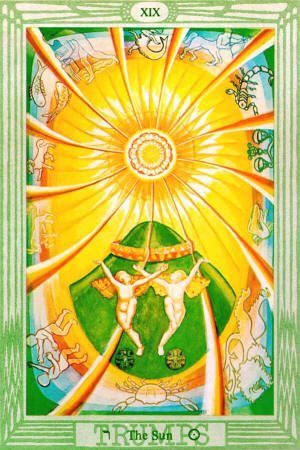
Perhaps it is not anti-climactic to this inquiry to consider whether
or not the elements of C. S. Lewis’ Narnia works may reflect the
content and perhaps the sequence (this occurs relatively late in the
story, as the card occurs toward the end of the Trumps) of the Tarot
trumps in general, beginning, then, of course with the Magician and
the previously understated title of "The Magician’s Nephew".
Are we
looking at the title subject of his "The Dark Tower", the intriguing
addition to his Perelandra Trilogy? Does the appearance of the Queen
represent the progression to the High Priestess card, and her wild
ride on a carriage the Chariot? Lewis may be, by coordinating the
themes of his writing with the Tarot, unlocking the meanings of the
Tarot further while pointing toward further illuminations of his own
concealed meanings.
Taking this all further into the context of precocious magickal
science, we may find that the hill, at least in Crowley’s version,
represents a possible quantum mechanical expression, a suggestion
imparted by a number of his other cards, and his own constantly
re-emphasized knowledge of and involvement with the so-called
"mundane" sciences.
Further, if we restate the observation that Lewis’ work seems to
include reference to a trump of Crowley’s tarot, in addition to that
of other decks (The arrival on a flying horse in Lewis’ book also
refers to the child riding the horse before a wall in the Ryder
deck), besides integrating what seems to be known about some
subtler, more alchemic meanings of the Ryder cards, consider any
possible relationship between Lewis’s knowledge and that of
Crowley,
and look closely for parallels between their expressions, in spite
of the peculiar sensationalist context of the quizzical and pedantic
ways the religious "status" of these two individuals are perceived
by mainstream Christians. They may well prove to be something far
other than the diametric opposites they appear to be, although
something of their approaches is indeed distinctive from one
another.
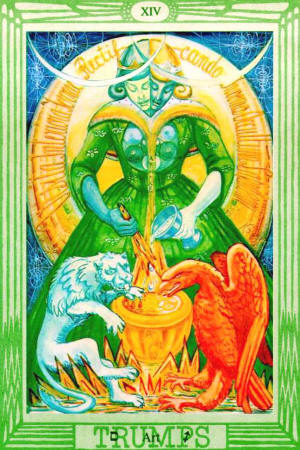
In doing so, there is perhaps something conspicuous when we look at
Crowley’s "Art" trump (click
above image), whilst we have these fabled "blue apples" on
our minds, and that is the seven nuclei of the Nitrogen atom which
appear on this card, flattened within the nucleus and symbolizing
the atomic number rather than the atomic weight, identical to the
manner in which many ancient diagrams of atoms do, and with the
azure coloring to assure us that the etymology of "azure" and "azote"
that tends to associate them is indeed valid, even though the
proposition has led some authors to prematurely criticize it for
having distorted the frame of reference to suggest it means the
ancients "worshipped Nitrogen". The worship of Nitrogen may be
ludicrous, but rather than insisting on worship, we may wisely
insist on the Nitrogen, and momentarily set aside the provisional
idea of worship; the ancients recognized and seemingly anthromorphicized this element, and others.
The significance of Nitrogen in our context, of course, is that it
seems appreciably missing from the present Martian atmosphere -
Richard Hoagland hopes, with some reason to believe, that Mar’s
Nitrogen has remained underground on the planet, and that it
conveniently has a very difficult time getting out of any serious
discussion of ectoplasm. While ectoplasm remains largely "Ghostbuster"
stuff, and the stuff of mostly privileged mediums to consciously pump
a little of, it’s been alluded to many times by mystics of many
peoples who supposedly didn’t even know what nitrogen was, often
replete with indicators of it’s atomic number or weight, and it may
yet play a large role in magickally transforming other worlds, and
looking scientifically at its nature does anything but discourage
that thought.
In a manner of speaking, these are the "blue apples" to which
Sauniere’s cipher refers, in a close parallel with the evidence
provided for similar styles of symbolism in support of documenting
part of the actual history of the time-reversal science of
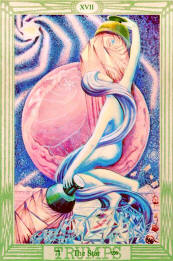 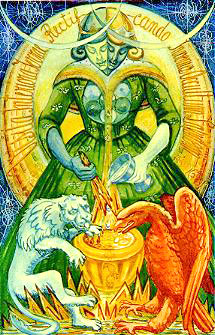 the
alchemists known as palingenics. the
alchemists known as palingenics.
The Art (left) and Star
(click right image) trumps from Aleister Crowley’s Thoth
tarot. The Star card has been cited elsewhere on this site (as other
of the Thoth trumps have been associated with the goal of Martian
colonization at this site, such as the "Face on Mars" page) for the
strong indications that it embodies the message of the concerns of
colonizing Mars - through in fact the magickal science to turn it
into an earth-like planet.
Compared with the chemical symbolism of
this card’s counterpart in the Ryder tarot, the observation that
nitrogen still existing beneath the surface of Mars, as
Richard
Hoagland hopes, may exist bound in the form of Nitrates.
The Art card (above image) shows an
atom of Nitrogen and what may be the scalar
techniques used to deliberately liberate it from the Martian soil en
masse. Crowley’s elaboration of this card in his
Book of Thoth gives
this card perhaps the most attention of any, and his voluminous
notes touch on the Emerald Tablet’s symbolism - symbolism that may
yet unlock the hyperdimensional physics of uprisings of energy in a
tetrahedral pattern at latitudes of 19.5 degrees north and south on
bodies throughout our solar system.
They also touch on the alchemic symbolism that the green robe
symbolizes (the all-important) vegetation, although he as quickly
next denies it as he soon does the same in regard to the appearance
of the acronym "vitriol" appearing on this card, formed by the
message advising visiting the interior of the earth.
It’s pretty easy to believe this is referring to tapping matter and
energy flows from inside planets in the line of arranging their
constituencies to be rapidly earth-like, and the fact that alchemy
may yet be proven to involve ectoplasm should not be overlooked, for
in suggesting that tapping these upwelling may be done very similar
to how mediums may tap it to produce manifestations, he is also
using here the alchemic symbol of the hermaphrodite, who in older
forms can often be seen far more blatantly to be tapping this
amorphous, clammy, "animal magnetic" stuff of the earth.
We shouldn’t rule out the similarity of the animal symbols here to
the animal symbols representing certain energies of geomancy and
feng-shui, or the rules by which they present themselves in a
fortuitous manner, for borderline science and
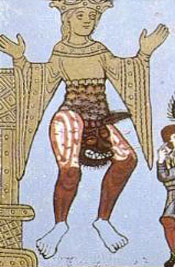 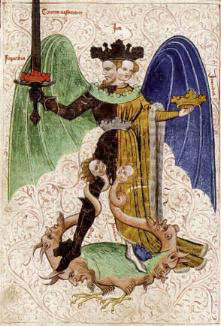 mysticism still
sometimes struggle to be sure that chi and ectoplasm are not either
intimately related, or one and the same, and the same symbolic role
for these animals as is found here may also be intended in the works
of the Inklings when they occur there. mysticism still
sometimes struggle to be sure that chi and ectoplasm are not either
intimately related, or one and the same, and the same symbolic role
for these animals as is found here may also be intended in the works
of the Inklings when they occur there.
Lewis’ deft use of symbolism may not in fact be so limited; the
riddle of Aslan, to judge from only the first two of Lewis’ "Narnia"
books, is a challenging puzzle. In "The Lion, the Witch, and the
Wardrobe", while he makes Aslan into a Christ-like figure who is
martyred and reborn, it’s perhaps hard to justify that Lewis’
replacement of Christ with this character could have been born out
of any genuine Christianity.
He seems more than ever to be less of
an insider, and even less of an infiltrator of Christianity, than a
commentator and benevolent critic from the outside, effectively
mistaken for an insider by his Christian audience, which is again
the same perception that a close look at his "Wormwood" and "Screwtape"
characters produces. Even while he must be aware of the magickal and
alchemical roots of his Church, he seems far more the magickian.
We could make short work of the proposition here, that the Inklings
combined the inspiration of ancient and modern science with the
occult, in the form of the Tarot, simply by bringing up the fact
that Charles William’s story, "The Greater Trumps", as the title
suggests, is centered around the Tarot... just as we could make
short work of guessing the possible hidden multidimensional secrets
in the Inklings’ work by simply referring to another of William’s
titles, "Many Dimensions".
It wouldn’t even be out of place to ponder whether this associations
born out of a phenomenal curiosity could have, like those of
others, included members of the Golden Dawn, the Theosophists, the
Rosicrucians, or the Freemasons, and eventually there isn’t much
getting around having the same thoughts about Lewis Carroll. Even
though the Fanthorpes only make the gentlest allusion to such a
possibility as Carroll’s involvement with the Prieure and
the
Inklings, the proof may, as with the Inklings, "come out in the
pudding".
It is the actual content of the work, and what may be hidden there,
that may be in the end by far the best indicator of the reality of
such a premise. (I’ve long been tempted to assign the obvious value
of the tachyon, a theoretical faster-that-light particle, to the
White Queen, who is "so far ahead of herself"... which is only to
start with). Suffice it that Carroll’s prerogatives, much like
those of the Inklings, and not ironically, those of traditional
peoples, may have been to forge an early start by weaving into a
child’s fables enough information to last several lifetimes.
Perhaps for now this quote from a webpage on "The Mathematics of
Lewis Carroll" will suffice as the beginnings of evidence that his
talents and interests were even more in accord with those of the
Inklings; Carroll, like MacDonald, in addition to being a fantasy
author, was a mathematician:
"His contributions to mathematics are
also quite numerous, ’..he devised a system for working out a
determinant (used for solving lots of simultaneous equations) which
is algorithmic (doesn’t need intermediate decisions), and he is
recognized as one of the founders of the theory of proportional
representation (voting procedures).’ He also gave much to the world
of creative or educational mathematics. He devised lots of problems,
games and puzzles for those of any age. Dodgeson [Carroll’s real
name, Charles Lutwidge Dodgeson] died in 1898 and it is said that,
"His books are among the most quoted works in the English language,
and his influence (with that of his illustrator, Sir John Tenniel)
can be seen everywhere, from the world of advertising to that of
atomic physics."
Science, of course, entails the premise of the art of being able to
make accurate predictions based on information. That’s a critical
key to when something should be identified as a science.
The premises laid down in here in general predict that familiar
threads should run through the writings of the Inklings, that relate
to such Templar-oriented things as Mars, and
tesseracts, and
"strange" energies, and that they will be perhaps far more than the
novelties of fiction.
I shouldn’t have been surprised, then, to tear into C. S. Lewis’
"Out of the Silent Planet", and within the first twenty pages, the
main character is not only kidnapped and on his way to Mars, but in
a room on a ship that, while the description of the ship that
follows it refutes it, is nonetheless a very accurate description of
a segment of a tesseract. (below image)
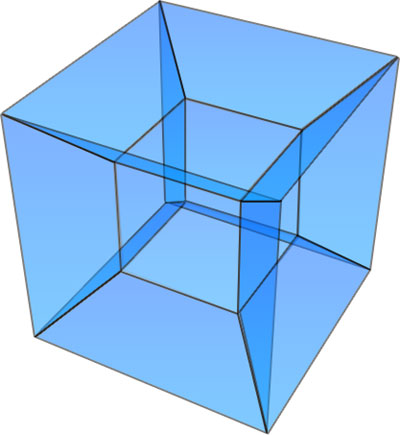
We are also told by the characters that the mechanism of the
spaceship is "exploiting the less observed properties of solar
radiation".
Does one necessarily need to finish the book, any more than having
had to open it in the first place to know what was coming, to make
more accurate predictions, and meaningful speculations?
Among the "less observed properties of solar radiation" are those
connected by Vedic texts to
the ancient aircraft of India, the
miraculous Solar Science of ancient India, which in turn may both be
connected to the ancient science of Egypt, and not surprisingly, the
Martian monuments seem to have a consistently Egyptian flavor, very
much as a replica of the Face on Mars in New York state is not far
from pyramids itself.

The pyramid of course can be considered to be one sixth of a
hypercube, or tesseract, as the description in Lewis’ work also
suggests a pyramid, upside-down, seen from the inside.
If we experimentally assume what seems to be the usual, that Lewis
is close to a source of initiated science in the form of George
MacDonald and the Priory of Sion, we may be given additional insight
into the problem that Richard Hoagland proposes, that of utilizing
what is, or should be, for practical intents and purposes, the
hyperdimensional origin of the sun’s energy.
Can we succeed in the assumption that there is something about the
sun’s output of energy that continues, perhaps holographically, to
have the hyperspatial quality of its hyperspatial origin? Or even
that there is something beneficial and useful in this that is not of
the order of energy, but instead of the order of this hyperspatial
quality? Most importantly, can we effectively connect such a view to
the whole spectrum of esoteric history and symbolism, and to the
spectrum of miracles or magick which we desire to facilitate, and
may require to make reasonable work of altering the face of Mars to
accommodate human needs?
Finally, there is C. S. Lewis’ fragmented manuscript, "The Dark
Tower", purported to have been rescued from the flames by Lewis’
gardener, Walter Hooper, after Lewis’s death.
Apparently a fourth part of his "Perelandra" trilogy, the
discussions of the mechanisms of interplanetary travel become
seemingly more explicit than ever. It’s also reinforced in Hooper’s
preface how the end of the first part of the Trilogy’s ends:
"After
remarking that his enemy, Weston, had ’shut the door’, to
space-travel through the heavens, he ends his letter (and the book)
with the statement that ’the way to the planets lies through the
past’, and that ’if there is to be any more space-traveling, it will
have to be time traveling as well...!"
Hooper speculates somewhat
convincingly that Lewis began the Dark Tower immediately after
finishing "Out of the Silent Planet".
Even before one pours themselves into the discussions that occur
within "The Dark Tower", one wonders what to make of this. The
premise is of course that however "fictional" and figurative this
may be, even if Lewis himself may be quoted as saying so, that it in
fact may be part of a concise knowing and even tested science of
interplanetary travel connected to the secrets of the Templars and
the mysteries of Rennes-le-Chateau, and the context of Lewis simply
being a Christian is no more absolute when applied to Lewis as when
such a dubiously restrictive label is applied to the priest, Sauniere.
In fact, much of the moralizing of "Out of the Silent Planet"
doesn’t seem as much to be an expression of Lewis’ profession to
Christianity as it does simply a necessity of fabricating an
adventure plot. Were it that Aslan had truced with the Queen and
"The Magician’s Nephew" had ended with a nice, "proper" Christian
ending like the magickal lion returning her world to life and her
gratefully changing her ways. Were it that the earthmen were as
willing as Ransom to get along with the Malacandrians, and they
should all live together happily ever after in peace. Rather than
Christian values, these bittersweet turns seem more like
disappointing black backgrounds for any shining details to stand out
against, be they snippets of scientific ideas, or odd words which
may yet be shown to form codes and ciphers like those of the Priure
de Sion.
As literally as we can take it, whether out of context or not,
because that is indeed the trick of the treasure map model is to
alter the "conventional" context in order to obtain the true
message, be it in the case of Sauniere, or, accordingly, in the case
of the Inklings.
Certainly, we know that eventually long range space travel must
overcome any time dilation which is predicted by Einstein; Alan
Holt’s NASA design in fact promises to overcome this difficulty. In
a way, therefore, space travel indeed must involve some "time
travel". But to Mars? Mars is certainly close enough that time
dilation isn’t so much yet a necessary concern.
We can of course refer to
Tom Bearden’s assessment of Tesla science,
that the technological mastery here indeed encompasses the mastery
of time, just as we can fall back on the Templars being in touch
with mastery of time-reversal magick.
But is this necessarily all?
Back To Contents
|



 the
alchemists known as palingenics.
the
alchemists known as palingenics.
 mysticism still
sometimes struggle to be sure that chi and ectoplasm are not either
intimately related, or one and the same, and the same symbolic role
for these animals as is found here may also be intended in the works
of the Inklings when they occur there.
mysticism still
sometimes struggle to be sure that chi and ectoplasm are not either
intimately related, or one and the same, and the same symbolic role
for these animals as is found here may also be intended in the works
of the Inklings when they occur there. 
